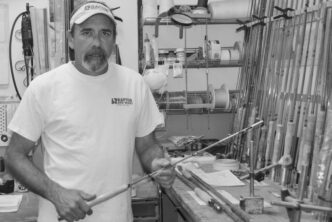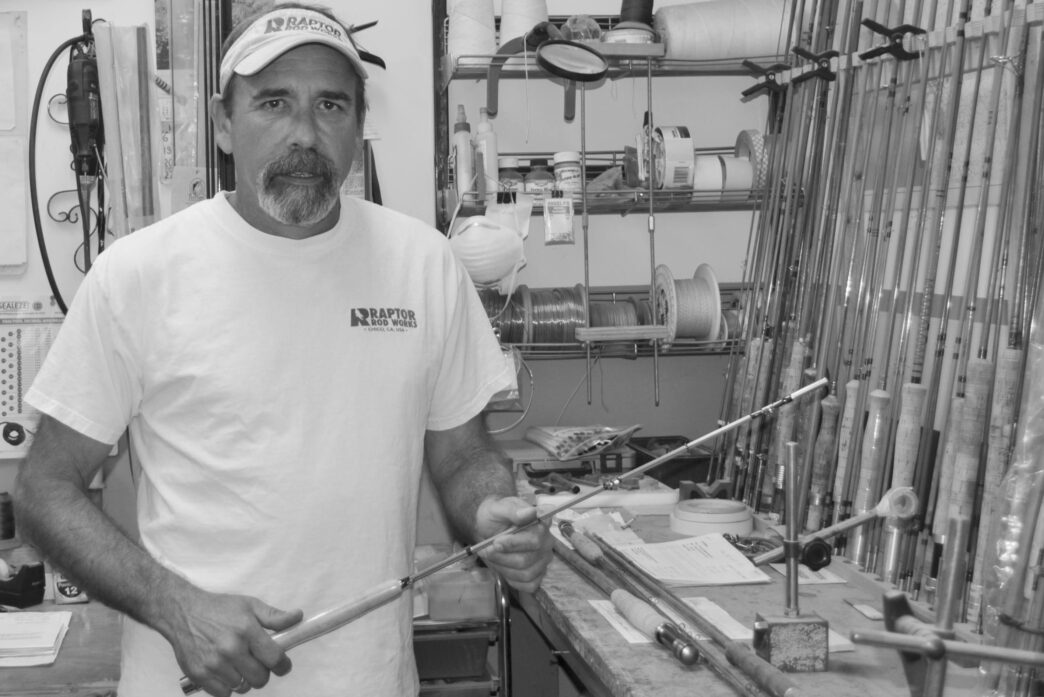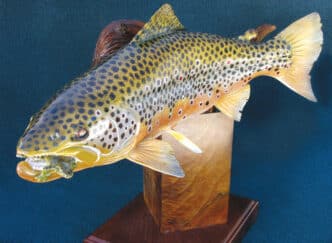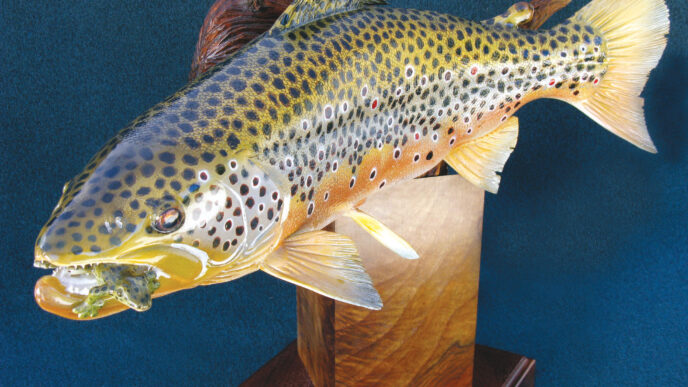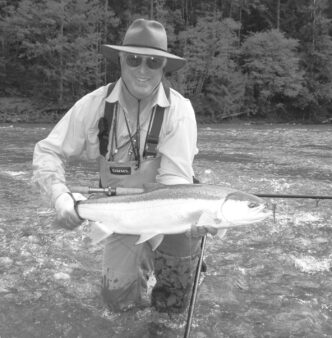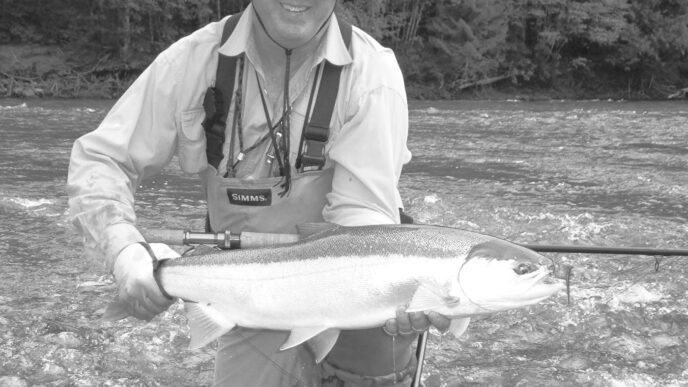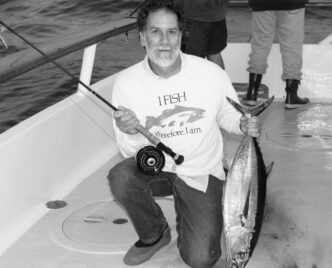Jim Clarkson knows fly rods — perhaps better than anyone else. As proprietor of Raptor Rod Works in Chico, he crafts custom-built rods and repairs rods of all makes and vintages. Indeed, he crafts and repairs all kinds of fishing rods, “from ultralight to unlimited offshore,” as his website puts it (http://www.raptorrodworks.com). In addition, he worked for years for Press Powell of the storied Powell family of rod builders and still offers a limited number of blanks built by E. C. Powell, Walton Powell, and Tony Maslin. The history of the development of the modern American fly rod has many chapters set in California, including the origins of major brands such as Scott and Winston. Few people are in a better position to comment on that history and the future to which it leads than Jim Clarkson.
Bud: When asked “What do you want to be when you grow up?” back when you were a kid, it’s unlikely that you answered “I want to be a custom rod builder and repair rods in Chico, California.” Raptor Rod Works may be the only operation of its kind in the United States. How did that kid end up doing what you do?
Jim: The question of the day through high school was “What are you going to do?” versus “What do you want to be?” and my standard reply was always, “I’m doing it.” I know that frustrated some people, especially Mom and Dad, but to me, even back then, the “here and now” was something to be savored.
It was my girlfriend’s desire for higher education and my desire of her that landed me in Chico back in March of 1983. After a long day of pounding the pavement in search of vocations, I noticed the sign on a prominent corner building, “Powell Fly Shop.” I was done pounding for the day, and I needed a diversion. Upon entering the store, the first thing that caught my attention was the enthusiastic greeting from someone who would become a lifelong friend, Allan Clements, manager of the newly formed Powell family retail venture. The second thing I noticed was the undeniable quality of the house-brand rod — Powell.
To step back in time a bit, I grew up fishing. I’ll never forget my first big fish, a four-pound catfish off a marina dock at Clear Lake, and I’ve still got the rod that did the deed, a 5-foot 6-inch solid fiberglass J. C. Higgins casting rod that to this day is proudly displayed in my shop. I was four years old at the time and fortunate enough to spend the better part of my next 20 summers on the lakes and rivers and in the surf of the Golden State. I also grew up in a family-owned machine shop on the San Francisco Peninsula, an environment that required precision and innovation every day.
We’re back at the fly shop now, and I’m looking at and carefully handling rods. To this point, I’d never fly fished, mind you, but quality is quality, and there was no denying its presence in the inventory at hand. I had to know where these were
made. Allan’s reply was, “Right in back, here,” and the scene that he showed me is as vivid today as it ever was: a small-scale machine shop, complete with lathes, drill presses, table-top milling machines, and a wide variety of tooling and fixtures of dedicated complexity. This in itself wasn’t uncommon to me. What was uncommon is what drives me to this day: this shop built fishing rods. What a concept! They have to come from somewhere — right?
What occurred to me was that these well-built, beautifully appointed objects not only required the close-tolerance work of my background, but an eye for beauty and an understanding of their intended use, as well. The next question seemed obvious to me: “You guy’s aren’t hiring, are you?” “Well, as a matter of fact we are,” was the heart-pumping reply, “but the man you need to see is off to a trade show.” Press Powell was the man I needed to meet. One week later, Press returned, and I spent 12 years as production manager of the Powell Rod Company, then another 14 as owner of Raptor Rod Works in its various incarnations, and I’m still “doing it.”
Bud: The story of the Powell family, from the development of hollow-build bamboo rods by E. C. Powell in the early decades of the twentieth century to the lawsuits of the early years of the twenty-first, after its sale to the Charles Schwab organization and the changes that followed, is one of the principal sagas in the history of fly-rod builders in America. What’s your take on it as a participant-observer?
Jim: Considering the amount of historical data, opinions, columns, and articles published on the topic, my take may seem surprisingly simple. I think all parties involved in the sale and purchase of the original family-owned Powell Rod Company had similar goals in mind, but the “how to” of implementing those goals was never explored to the detail it should have been. As the winds of change began to blow, it was apparent that there wasn’t a fair wind on the horizon. The difference between a fourth-generation family business, of which three were still involved in management decisions, and a deep-pockets corporate culture, with its purely profit-driven motivation, did not allow for smooth sailing from the get-go. I did not sit in on meetings, discuss options as they related to me, or for that matter even share opinions with anyone in a decision-making position — I simply made my own decision to venture out on my own and form Raptor Rod Works. It was as much the possibility of Powell relocating to the Sacramento area as it was the change of ownership that really drove my decision, because Chico is home. After my departure, I was still in very close contact with all parties involved, but on a more or less superficial level. As rumblings of legal recourse by both sides emerged, I further removed myself by establishing myself as an expert witness with a $250-per-hour price tag, which in the long run meant I continued to build rods at the workbench, not attend depositions at the conference table.
Bud: More broadly, you’ve been part of the story of the development of the fly-rod industry in the United States and the role that California has played in it. I want to ask a few questions related to that.
Like Powell, most companies started out as small, local operations. Some eventually grew into much larger enterprises. I’ve read that the Powells were skeptical about a rod-building company getting too big. Is there an optimal size for an operation that serves what is, after all, a limited market? What are the trade-offs that occur as a company grows? How do these factors affect their customers?
Jim: One needs to realize the limited size of the market to realize the optimal size for a rod-building operation. I think an awful lot of consumers would really be surprised by the relatively small size of most the physical operations of U.S. rod building.
As one attempts to increase the share of the market, marketing itself almost becomes the objective, and therein lies perhaps the single biggest trade-off for consumers. Press Powell said this many times over the years, and it still rings true: “Lots of people can build great rods, not a lot of people can sell them.” However, it was never purely a money game with Powell Rod Company. The rods carried the family name, and that meant something.
Remember that catch-and-release fishing was not in the vernacular when fly-rod building began. Rods were built as tools to supply food and evolved into the enjoyable implements of recreation we’re all familiar with many generations later. In the early 1920s, the approach was to build a quality product with a true purpose: “Why do we need to build more? It only means we need to sell more?” In retrospect, I tend to agree. Once the production end of a rod-building operation exists to support the marketing end, things get out of whack rapidly.
A real trade-off for consumers today is that the larger the presence a rod maker projects through printed, Internet, or consumer-show exposure simply means that they are likely to have the most expensive rod, not necessarily the best. Today, more than ever, there are great rods at almost every price point, but the downside is that there are less-than-great rods at almost every price point, as well. This can create confusion if one overlooks the real roots of building and selling U.S.-built fly rods: word of mouth, referrals, and products coming from sources with long-term, strong commitments to innovation and quality. I guess what I’m trying to say is that the size of a rod-building operation should not be overshadowed by how it has been shaped by the marketing department.
Bud: You’re in the unique position of being able actually to lay hands on, build, and cast a huge variety of fly-rod blanks, from original Powell blanks to the latest rods made of the latest materials, plus a wide range of older and even historical rods, as well as rod-building components. What changes in the way that rods are designed stand out over that time?
Jim: The U.S. rod market today offers more performance to the consumer than at any other time in history and for one basic reason, in my opinion, variety. That’s because you can’t really discuss performance without factoring in preference. I’m getting more and more requests for slower, more moderate-action fly rods, for example. I think what this demonstrates is that performance is highly subjective and to a lesser degree geographically and preferentially driven. The late 1970s ushered in the era of tubular graphite rods, but today there are more models, brands, and makers of quality bamboo and fiberglass rods available to the consumer than at any other time in history. And a rod that was good in 1960 is good today and probably worth considerably more than when new. The appreciation versus depreciation of a fly rod, I’ll bet, is a factor rarely defined as performance, but it’s a consideration, too.
In my lifetime, most of the technologies that have allowed for quantum leaps in rod design and performance have, in essence, trickled down from other technologies and economies. The application of those technologies has been done by some highly dedicated, motivated, and qualified individuals who have targeted fly-rod design with some amazing results. Lighter weight, smaller blank diameters, and stronger materials are all advancements that have come in small doses and have allowed for rods that would not have been possible even 10 years ago. Aerospace, defense, and even the automotive industry are where a lot of our rod-building materials and processes have been spawned.
I think an important part of performance also needs to be looked at from an industry-wide perspective. The lightest weight, strongest, smoothest-casting rod of today would be of no net gain if it weren’t for commensurate advancements in fly reels and lines, leader and tippet materials, right down the line to fly-tying materials, hooks, and fishing techniques.
To a certain degree, consumer demand drives industry advancement, too. It wasn’t the prevalence of four-piece rods that created the fly-fishing travel business — quite the opposite. Until the mid-1980s, four-piece rods were “pack rods” intended for backpacking. It was the pioneers of fly-fishing travel — the likes of California’s John Eustice and Mel Krieger — who created the niche to be filled. The rod-building industry responded then, as they are today with the availability of switch and Spey rod designs. The introduction and reintroduction of fiberglass by a variety of makers, the continual advancements in segmented graphite, graphite and glass composites, and bamboo — most with direct or indirect, historic or present day California connections — simply validates the role of California rod building and design over the years.
There was a period in which I feel the rod-building industry misled the consumer to some degree. I can assume that many California Fly Fisher readers have attended a fly-fishing or sportsman’s exhibition in which the “casting pond” had a prominent position. While providing an excellent venue for casting the latest models of rods, the industry’s initial response to that concept was to focus on rods designed with one criterion above all others — to cast long distances, period. Granted, casting 75 feet with relative accuracy provides a certain sense of empowerment, but to do so while elevated a couple of feet above the water with 90 feet of unobstructed back-cast clearance in a wind-free environment really does not define “performance” in my opinion.
Bud: There have been what might be called “fads” in fly-rod design, or at least enthusiasms that eventually died down, such as the vogue for short cane rods among those influenced by the example of Lee Wulff, and then there has also been genuine progress. How do you evaluate the current turn toward two-handed and switch rods in these terms? Where, as you see it, is fly-rod design headed?
Jim: What I see is not only the consumer becoming more educated in the sport in general, but employing different approaches to fly fishing and fishing in a greater diversity of locations well. As I see it, the industry as a whole needs to be very responsive to this, or only the segment that is responsive will prosper. There are more anglers drifting and floating rivers while fly fishing today, there are more anglers fishing offshore, more anglers traveling to destinations where the gear needs to be tailored to the conditions to perform best. Not to oversimplify industry trends, but I think where rod design should be focused therefore is really Business 101 stuff.
However, I feel that perhaps a decade of the most rapid technological advancements in rod design has to a certain degree allowed the cart to get ahead of the horse on some big-picture performance issues. The most advanced materials on earth prove no benefit if the quality control is not addressed properly. The best warranty in the industry isn’t worth much while you’re on the Kamchatka Peninsula for that trip of a lifetime. The “trickest” rod on the market doesn’t do much if it can’t be delivered in time to meet a deadline or if it requires a three-week tour through the warranty department on the after-the-sale service.
I also feel there are some more “fads” on the horizon, some of which have real promise and others that will be a flash in the pan or never even make it that far. Domestically, I predict a wave of rods designed for “urban” fishing, and “coarse” fish will be gaining popularity. These approaches are becoming hugely popular throughout Europe, and as fly fishing continues to become more globally homogenized, we’ll be seeing them grow here. Another trend that I personally find really refreshing is the number of quality bamboo rods being built by individuals throughout the United States — fiberglass as well. There’s almost a revival of sorts of the small-scale, hand-built rods available on a very limited basis. Restoration and renovation of early American rods is more popular now that ever, whether they be handme-downs from one’s family or just long-lost companions that have spent too much time on the shelf. Fly fishers are realizing the assets of many rods from the late 1940s through the late 1970s.
Bud: A while ago, California Fly Fisher ran an article by Larry Kenney about building one’s own rod from a blank and the components one most desires, complete with a sort of cost-benefit calculus. (See “Gearhead” in the May/June 2009 issue.) Given your experience, what advice do you have for those fly fishers who would like to build their own rods?
Jim: I definitely remember that article and was glad to see what it put into print. I’ve felt for years that home rod building is overlooked. The single biggest ingredient in a successful rod build is patience — period. Many people feel the tooling costs of building one’s own rod are prohibitive, but in reality, most avid fly tyers I know have more invested in fly-tying tools than what is required for a rod build. If you can come to grips with the reality that your first home-built rod won’t look like the off-the-shelf production rod, that’s half the battle. I’ve yet to meet a trout that cares what a rod looks like.
The single biggest mistake I see made by first-time home builders is their insistence on utilizing the cheapest components available. The first rod you build should be exactly the rod you want. It is a safe bet that the first rod you build will be the most time-consuming rod you build, and at the end of the project, I can’t see you being satisfied with taking the longest time to build the least desirable rod you may own. The other downside to this philosophy for the home builder is as the guy who builds it, you are now the guy who rebuilds it in the event of damage or breakage. I guarantee you’ll enjoy building rods utilizing quality components much more than rebuilding them from marginal-quality components.
Some people approach building their first rod via rod-building kits. I see a dozen clients a year who have purchased a kit, have become frustrated, and have ended up passing it on to me for to complete the build. Most mail-order kits are really a loosely grouped assortment of parts and pieces with very little thought of proper sizing, fitting, and appropriateness to the finished rod. I offer rod-building kits that have gone through a secondary inspection of every component, with all components properly sized and appropriately prepared for the actual assembly and build. Another level of kit that I offer is actually a carryover from the old days at the Powell Rod Company, and that is what we called the Ready-to-Wrap-Kit (RWK). The RWK is the blank with reel seat, grip, and tip top mounted, leaving just the wrapping and finishing of guides to be done to complete the rod. This is great way for someone to ease into the whole concept of building a fly rod at home.
Bud: Custom or not, how do you recommend that someone goes about evaluating and choosing a fly rod?
Jim: Whether it be someone’s first or twenty-first rod purchase, asking a few basic questions can go a long way in making sure that you end up with the right rod. First, I think it is important to make sure that you are not considering a rod that either duplicates or overlaps to a great deal an existing rod you may own and enjoy fishing with. Replacing a rod that isn’t meeting your needs is one thing, but I see so many people shopping for their sixth or seventh rod, and everything they own is between an 8-foot and a 9-foot 5-weight or 6-weight. While I’d like to see everyone own a dozen rods, I like to see every rod purchased add the maximum amount of versatility to one’s arsenal. In other words, if you take significant steps by length and/or line weight with each rod, by the time you own five rods, you should have serious swath of water covered very efficiently.
A situation that is becoming more and more common is with individuals shopping for a rod intended for a once-ina-lifetime trip or just very limited use. Evaluating a rod intended for fishing two to three days per year should involve a different set of criteria than evaluating a potential “go to” model. Casting style, ability, and preference all need to be factored in.
It used to be that virtually all of the factories offered custom options at some level. Now that seems to be rare. With a custom-built rod, you can select every component, from reel seat, to a fighting butt, either fixed or detachable, to grip shapes and sizes, to rod-case options, including the ever-popular “no case” option, right into the “gee-whiz” features such as colors and custom inscriptions.
Even factory rods are great candidates for customization, whether it be gripshape modifications, retrofitting with fighting butts, or simple personalization with an inscription for yourself or gifting.
Bud: Since you also repair rods of all vintages, and even have developed proprietary techniques for doing so, you must be a walking compendium of the ways people manage to break a fly rod. What are the most common ways for people to try to avoid — and what are the weirdest you’ve seen?
Jim: Next to car doors and ceiling fans, the single biggest cause of rod failure is out-of-tolerance ferrule fits. Anyone who has had a rod fail right below the female ferrule has fallen victim to this. This is a tough one to avoid if initial factory quality control has not been performed to specification, so we’ll skip that for now. Backcasting hook points and split shot into the blank is a popular form of rod breakage. Aluminum boats are particularly aggressive toward graphite rods, as are truck tailgates. And of course the good old-fashioned falling down accounts for its fair share of breakage.
The reality is that virtually every rod made today is designed to withstand any and all loads it is intended to encounter under normal fishing conditions. “Normal” tends to be overrated, in my opinion. As Gary Loomis has said for years, “I can build a rod you can’t break, but you wouldn’t want to fish with it.” So if you go beyond the intended loads and stresses that a rod is designed to encounter, guess what, it will break.
Something to be aware of is that most rods with a matte finish are really a rod with no finish at all. What this means is that any nicking or scratching on the blank and you are instantly into structural fiber, whereas a rod with a gloss or color-and-gloss coat essentially has a .002-inch or thicker protective coating that buys a considerable amount of protection against light scuffing and nicking that can weaken unfinished rods. When it come to weirdness, as Hunter S. Thompson would have said, when the going gets weird, the weird turn pro. Dealing with all types of rods for 25 years, I’ve seen some serious weirdness, but on the fly-rod front, I think the least common, yet most devastating is the old “ loose leader sucked up in the vacuum cleaner” tear jerker. Every time I see a rod that has fallen victim to this I can’t help but visualize an almost comical scene, but the reality is it is rarely funny. On the flip side, this method of rod breakage often allows for the purchase of a new rod with “the wife’s” approval and support.
Teething puppies and rodents do their fair share. A relatively new one exclusive to graphite rods is the short-circuiting (melting) of them off the trolling motor battery terminal to the aluminum driftboat hull. My all-time favorite, however, is the guy who drives up to the shop, presents a rod broken with white paint on either side of the break, and assures me that it “broke on a fish.” I can tell what color rig he drives without even looking out the door, and he thinks I’m “Godlike.”
Bud: After dealing with fishing rods all day, do you still get out and fish?
Jim: I’ve fished for 45 years in nine countries and 19 states and still feel like I’ve barely skimmed the surface. On the other hand, every time I come home, I can’t help but realize that no place I’ve ever been offers the quality, variety, and overall yearround opportunity for fly fishing that California does. I feel blessed to have selected a path that allows for this lifestyle, to have met the people I have, to have been a part of this ever-changing industry, and to wake up every day looking forward to more.
Bud: Here we are at the traditional Silly Tree Question. If you were a tree, what kind of tree would you be?
Jim: Now we’re really getting out there. A palm tree. It is so named for its resemblance to one’s outstretched hand. Also, it’s a symbol of triumph. It’s not a true tree by definition, but referred to so commonly it has become accepted as such. It covers the broadest swath of latitude of any other tree and circles the earth, withstands the strongest winds on the planet, and has no commercial value except while living.



